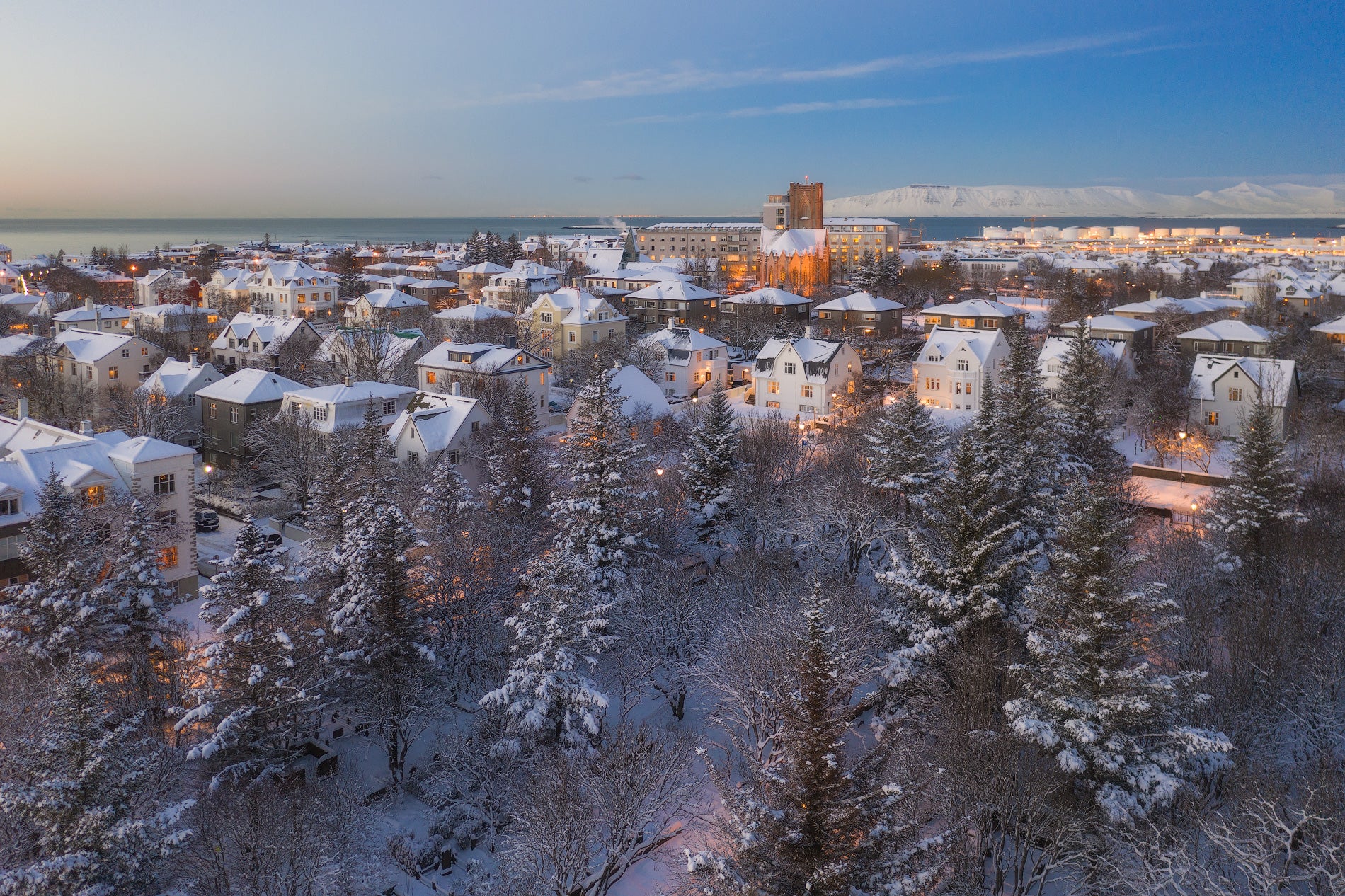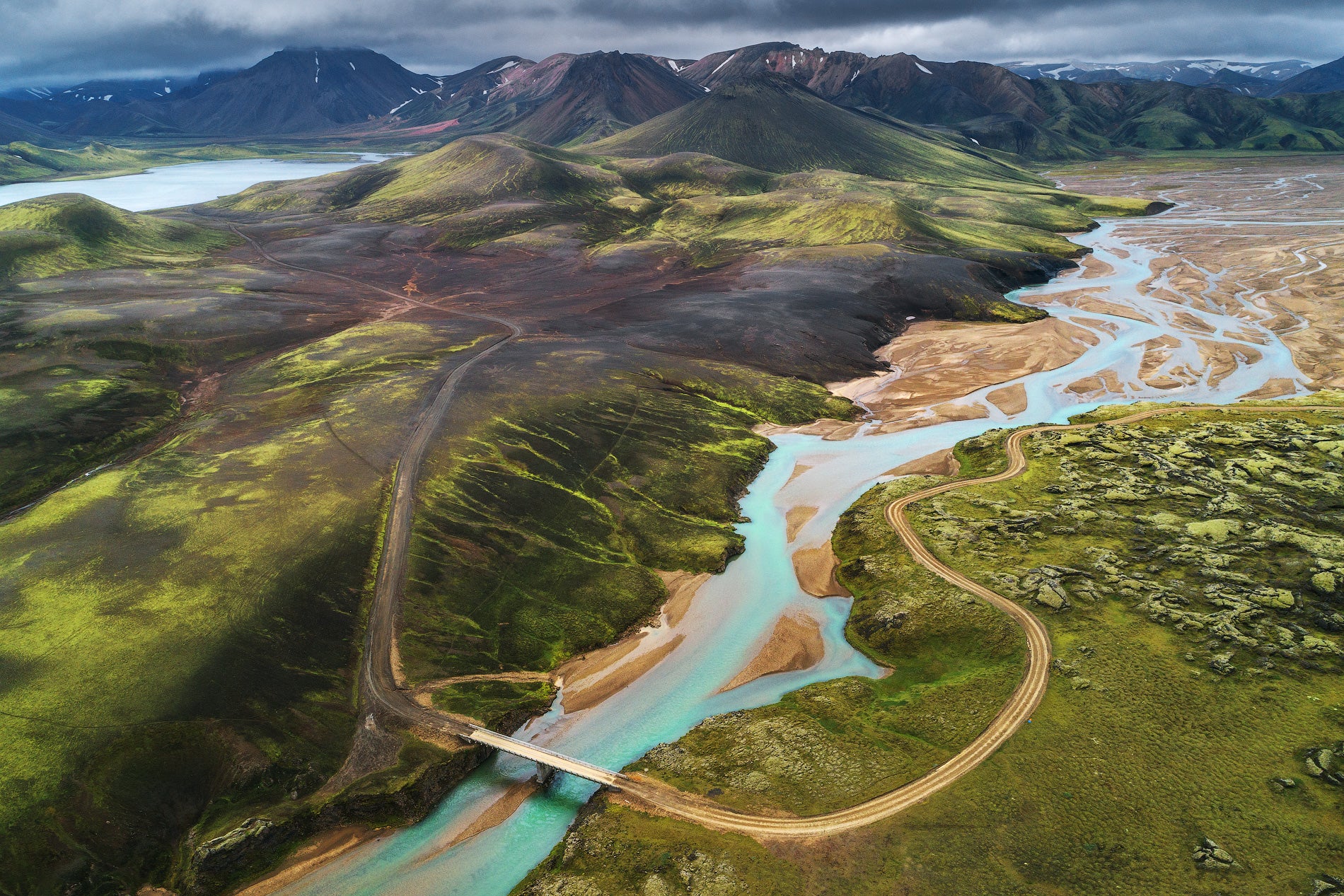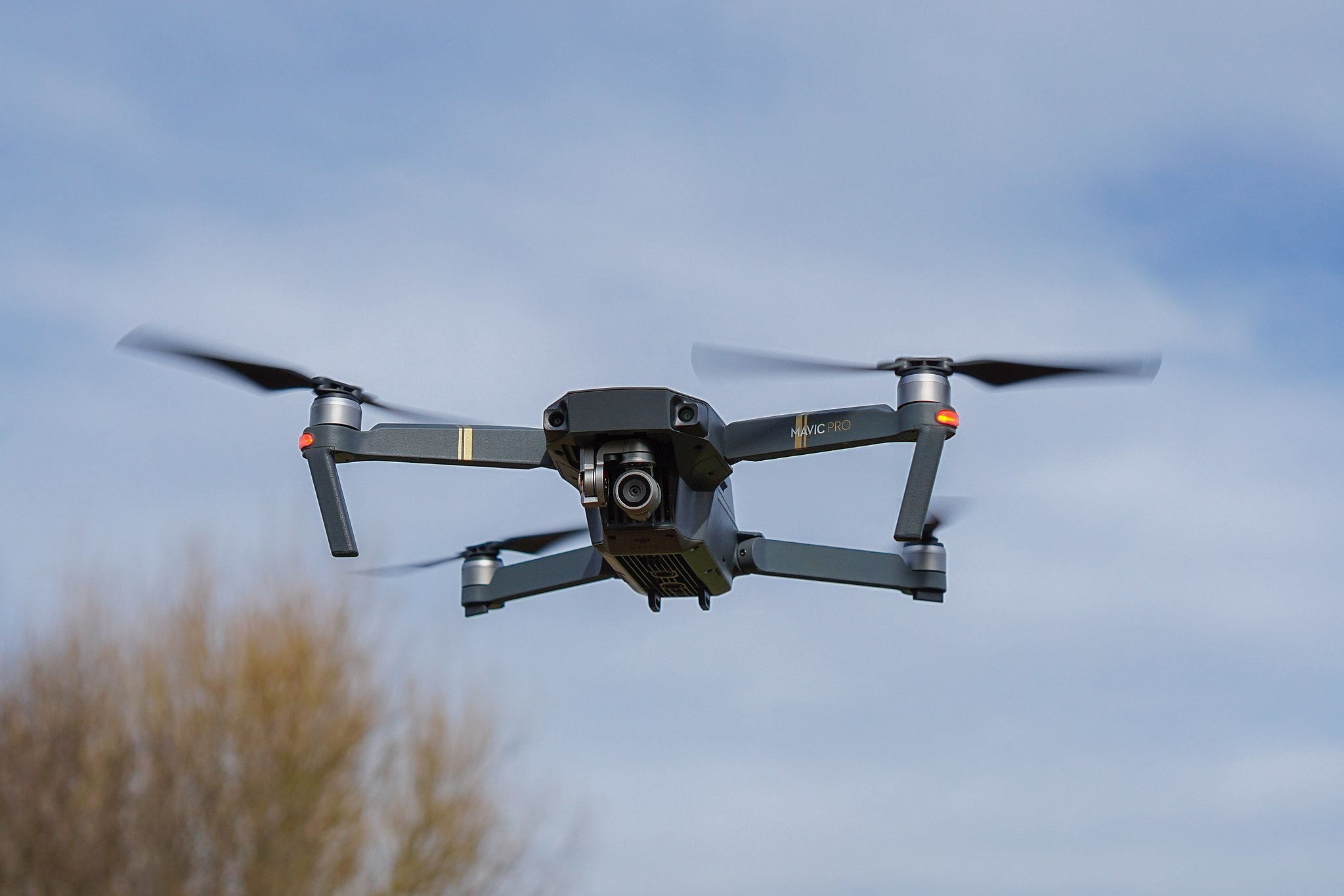
Iceland is a photographer’s paradise. It’s one of those destinations where there are landscapes around every corner waiting to be discovered. And it’s not just about the variety of colours, contrasts and scenes; it’s about the quality. This place is breathtaking from every angle.
- Check out these Camera and Gear Reviews
- See The Best Camera Gear Recommendations for Photography in Iceland
Angles are important in photography - especially in a location that’s all about scale, like Iceland. Capturing those towering waterfalls, endless glaciers and barren stretches of volcanic desert relies on perspective. Sometimes it’s hard to appreciate all of that epicness from the ground level, which may explain why flying drones in Iceland has become so popular in recent years.
In part, that’s because drone technology has come a long way in a short period of time. These flying robots are no longer as intimidating as they used to be. Almost anyone can get behind the controls and capture incredible photos and video.
- See also: The Ultimate Guide to Drone Travel Gear
 Rugged Beauty. Photo by: 'Iurie Belegurschi'.
Rugged Beauty. Photo by: 'Iurie Belegurschi'.
But shooting from the air is still very different to shooting on the ground. Where do you even start if you want to mix things up by introducing a drone into your photography sessions?
Well, the first step towards flying a drone in Iceland is, obviously, choosing the right aircraft to take with you. To get it right, you’ll have to factor in what and where you’re planning to shoot, as well as how much money you’re willing to spend.
Here are some of our favourite options, which should offer the portability, power and performance you’ll need to take in Iceland’s many sights from above. You might notice a pattern: almost all of them are made by the same manufacturer, DJI. That’s not because we’re biased. It’s because DJI has an estimated 80% of the market for a reason.
So, which drones should you consider packing for your trip to Iceland?
- See also: The Ultimate Guide to Drone Vacations
DJI’s Latest Drones: The Mavic 2 Pro and Mavic 2 Zoom
At the end of August 2018, DJI unveiled two new drones that could turn out to be ideal for an aerial photography adventure in Iceland: the Mavic 2 Pro and the Mavic 2 Zoom.
 The Water Falls. Photo by: 'Iurie Belegurschi'.
The Water Falls. Photo by: 'Iurie Belegurschi'.
On launch day, DJI President Roger Luo said “Today, we enter a new era of aerial photography with the introduction of DJI’s new flagship product, the Mavic 2 series. The Mavic 2 Pro and Mavic 2 Zoom will enable photographers and videographers to take their inspirations to the air quickly and elevate their creative ideas to new heights.”
This is exciting. Both drones are upgrades of the original Mavic Pro, which we will get into in more detail below. The only difference between the two new models is the camera.
As the name hints, the Mavic 2 Zoom is the first foldable consumer drone with optical zoom.
 A Sprawling Landscape. Photo by: 'Iurie Belegurschi'.
A Sprawling Landscape. Photo by: 'Iurie Belegurschi'.
It has the equivalent of a 24-48mm optical zoom and 2x digital zoom, offering in effect a 96mm telephoto lens for 4k lossless zoom at full HD video resolution. The camera has a 12mp 1/2.3″ CMOS sensor.
The Mavic 2 Zoom also features DJI’s new Dolly Zoom flight mode. This gives aerial photographers a new creative tool that warps the perspective by automatically zooming in as it flies away from its subject.
The standard Mavic 2 Pro comes with a Hasselblad camera with a 1-inch CMOS sensor and a 10-bit Dlog-M colour profile. The result is images and videos with four times as many levels of colour per channel when compared to the original Mavic Pro.
The new 20MP camera has an adjustable aperture from f/2.8-f/11 for improved image quality and superior light and colour performance.
 Golden Midnight Light. Photo by: 'Iurie Belegurschi'.
Golden Midnight Light. Photo by: 'Iurie Belegurschi'.
But arguably, the main features are what both drones have in common. As you’d expect, both come with all of DJI’s autonomous flight modes – ActiveTrack, which allows you to highlight a subject for the drone to follow, and TapFly, which is exactly what it sounds like, as well as a range of one touch camera shots including HyperLapse.
In terms of safety and performance, both of DJI’s latest drones have the same setup: an array of sensors that make it near-impossible to have a serious crash. Both Mavic 2 models have omnidirectional collision avoidance, combined with DJI’s APAS (Advanced Pilot Assistance Systems). These ensure your drone will be safe in complex environments with a combination of sensors and algorithms.
 Rivers Snaking Below. Photo by: 'Iurie Belegurschi'.
Rivers Snaking Below. Photo by: 'Iurie Belegurschi'.
Both models have a top speed of around 45 mph and can stay airborne on a single battery for 31 minutes. DJI’s OcuSync transmission system provides 1080p live video streaming and a maximum range of up to five miles.
As you might expect, DJI’s newest models don’t come cheap. The Mavic 2 Pro is $1,449 USD. The Mavic 2 Zoom is slightly cheaper, $1,249.
Both of these models represent the benchmark for drone technology in 2018. Just imagine the creative fun you could have in Iceland with the Mavic 2 Zoom’s Dolly Zoom function!
- See also: Should I Take My Drone to Iceland?
The DJI Mavic Pro
The Mavic Pro is DJI’s flagship drone and certainly the company’s best seller at the moment. Although it was launched at the end of 2016 – which makes it a relative dinosaur in drone terms – it has stood the test of time because of the balance it finds between price, portability and performance.
Portability is the key here. Before the Mavic Pro, aerial photographers looking to shoot 4K video didn’t have many affordable and portable options. The Mavic Pro’s four legs fold up, making it just about small enough to fit in a large pocket, but certainly compact enough to fit inside a small backpack.
That size adds to the impression that this is a drone for people on the go, who want to shoot spontaeneously rather than spend ages unpacking and setting up. For that reason, the Mavic Pro has become popular with travellers.
With its miniature form factor, you might expect the Mavic Pro to make some sacrifices in terms of performance and camera quality. But it doesn’t, at least not to an extreme. Battery life stands at a respectable 27 minutes, the operating range is around 7 km and the top speed is over 60 km/h.
It’s also got a bunch of functions – like every drone on this list – to keep you and your drone safe. These include forward and downward facing obstacle avoidance and a smart return to home feature.
 A Mountainous Horizon. Photo by: 'Iurie Belegurschi'.
A Mountainous Horizon. Photo by: 'Iurie Belegurschi'.
For photographers, the most important aspect will be the camera. The Mavic Pro’s sits on a 3-axis stabilised gimbal. The 1/2.3”(CMOS) 12 megapixel camera can shoot 4K video at 30 fps and full 1080p HD at 96 fps.
So how much does the Mavic Pro cost? Well, because DJI is expected to be releasing new models in the near future, the Mavic Pro is currently on sale at a very reasonable price of $899. There’s also a slightly updated version - with more flight time and less noise - the Mavic Pro Platinum for $200 extra.
Should you take the Mavic Pro to Iceland? Definitely. It’s portable, sturdy enough in windy conditions and so quick to get up off the ground and into the air. You never know what’s coming around the corner in Iceland; the Mavic Pro will react as quickly as you do.
The DJI Mavic Air
The DJI Mavic Air is the company’s most recent drone, having been launched at the start of 2018. In many ways, it can be seen as the smaller brother to the Mavic Pro, with a few important differences.
 Veins of Iceland. Photo by: 'Iurie Belegurschi'.
Veins of Iceland. Photo by: 'Iurie Belegurschi'.
The first is size. The Mavic Pro was DJI’s first shot at a portable, personal drone. The Air takes that to the next level. It weighs just 430 grams and folds up to just 168x83x49mm. That makes it half the size of a Mavic Pro and 40% of the weight.
There are some sacrifices that have to be made when going miniature. Just like DJI’s smallest drone, the Spark, the Mavic Air has a shorter flight time than the Mavic Pro, at just 20 minutes. That can be annoying when on shoots, but as long as you’ve got spares to hand you can land, swap them in and be on your way in a matter of seconds.
The Mavic Air comes with 8GB of built-in storage, as well as a slot for an SD card - which is a nice touch.
 Snowcapped Beauty. Photo by: 'Iurie Belegurschi.'
Snowcapped Beauty. Photo by: 'Iurie Belegurschi.'
The best things about the Mavic Air are its upgrades in terms of autonomy and safety. For beginner pilots who are a little nervous, crashing the Mavic Air is going to be a challenge. That’s because it can sense obstacles in 3 directions: to the front, to the back and below.
The Mavic Air’s Flight Autonomy 2.0 system processes information from seven onboard cameras and infrared sensors and builds a 3D map of its environment. You, the pilot, get more precise hovering and the peace of mind of a drone that can sense obstacles up to 66 feet (20 meters) away.
The Mavic Air’s Advanced Pilot Assistance Systems also allow the drone to navigate autonomously in complex outdoor environments. It can actually sense and bypass obstacles automatically – which is great for tracking and capturing extreme sports while you enjoy the moment.
 Eye of the Highlands. Photo by: 'Iurie Belegurschi'.
Eye of the Highlands. Photo by: 'Iurie Belegurschi'.
The Mavic Air comes with a bunch of pre-programmed flight modes, designed to be activated at the touch of a button, like Boomerang. Oh, and there’s a number of gesture modes if you happen to like flying like a Jedi.
So what about the camera? There aren’t too many differences from the Mavic Pro’s 1/2.3”(CMOS) 12 megapixel offering. It can shoot 4K video at 30fps and full HD at 120fps. DJI has bumped up the Bandwidth from 60 Mbit to 100Mbit, and added better HDR algorithms preserve more highlight and low light details.
The Mavic Air was designed to be the Pro’s little brother in terms of price, not just size. So you can get it at the moment in a variety of colours for under $800.
So should you take the DJI Mavic Air to Iceland? Sure. The camera quality is excellent and it’s probably the most portable drone on the market. Just be sure to take a few spare batteries with you and avoid super-windy conditions. The Air is small and struggles in high winds, and in those conditions your battery life won’t be as long as might expect.
DJI Phantom 4 Pro
Stepping into the territory of professional-grade drones we have the DJI Phantom 4 Pro, a powerful, groundbreaking machine that in many ways is the perfect drone for capturing Iceland’s landscapes.
The P4 Pro was launched at the same time as the DJI Mavic Pro, towards the end of 2016. Since then it’s been at the top of the professional market for good reason.
So let’s start with the size. Weighing in at 1.3kg, the Phantom 4 Pro is way bigger than our previous two contenders. This drone isn’t folding up or fitting in your pocket. You’ll need a dedicated bag and the motivation to carry it around while you choose where to shoot.
But that size is needed to give the P4 Pro room for extra power that its smaller rivals don’t have. It has bigger battery that gives you 30 minutes of flight time per charge - which is ideal if you want to get some long exposure-time lapse type shots. It’s also faster – with a top speed of 72km/h – and can handle rougher winds.
- See also: Photos of Iceland From the Sky
 Soaring over Iceland. Photo by: 'Iurie Belegurschi'.
Soaring over Iceland. Photo by: 'Iurie Belegurschi'.
The P4 Pro has the same safety systems found in DJI’s other drones, and relies on three sets of visual sensors to build a 3D map of obstacles in front, behind and below.
So how about the camera? The Phantom 4 Pro has a 1-inch 20-megapixel sensor, and 12 stops of dynamic range to bring more light levels and offer higher performance in low-light conditions. It also has a mechanical aperture to eliminate distortion when you’re flying along.
On top of that, the P4 Pro can shoot slow-motion 4K video at up to 60 fps at a maximum bitrate of 100 Mbps.
In May 2018, DJI launched an iterated version of the Phantom 4 Pro, the P4 Pro V2.0. It’s not much different from the original, aside from new motors and propellers. These reduce the noise of the drone by up to 60%. That might sound like a weird thing to focus innovation on, but when you’re a self conscious drone pilot trying to get a quick shot, it’s an amazing idea.
The latest Phantom 4 Pro V2.0 is now available for $1499.
DJI Inspire 2
DJI’s Inspire 2 is arguably the best photography drone ever made. This is the drone that you will see on Hollywood movie sets. So if you’re thinking of visiting Iceland for a professional shoot, this might be your drone of choice.
In part that’s because, like the P4 Pro, the Inspire range is bigger, smarter and faster than DJI’s more personal-sized drones.
Power-wise, the Inspire 2 goes from 0 to 50 mph (80 kph) in 5 seconds, with a maximum speed of 58 mph (94 kph). It can descend at 9m/s. All of these may sound like a reel of numbers, but when you’re looking for shot versatility and the ability to capture a lot of angles in a single session, they make all the difference. The Inspire 2 also has a dual battery system, which gives 27 minutes of flight time, depending on which camera you’re using with it.
Which brings us to the cameras – plural. Unlike any of DJI’s other drones on the market, the Inspire range is designed to be modular, meaning you can swap in different cameras depending on the situation. These include the Zenmuse X7 and X5S.
See also: Private Photo Workshop in the Icelandic Highlands
 Midnight Light. Photo by: 'Iurie Belegurschi'.
Midnight Light. Photo by: 'Iurie Belegurschi'.
Both work with the Inspire 2’s CineCore2.1 image processing system. The Zenmuse X7 records video at up to 6K in CinemaDNG/RAW at 30fps and 5.2K in Apple ProRes, has 4 stops of dynamic range and captures 24 megapixel stills. Big.
You’ll also find all of DJI’s safety features packed into the Inspire 2. The drone also has another first person view camera, which a pilot can use to control the drone separately while another operator controls the main camera.
One final feature that’s ideal for somewhere like Iceland: The Inspire 2 has self-heating technology, which keeps the batteries at an ideal temperature to perform in cold conditions.
You get the point: this thing is an absolute monster. But all of that doesn’t come cheap. The Inspire 2, without a camera, costs $2,999. The Zenmuse X7 described above costs $2,700. In total that’s an expensive package. It’s up to you whether it’s worth it or not.
Final Thoughts
These DJI drones offer something for all kinds of photographers and videographers, whether you’re a beginner, looking for a family-friendly introduction to drones or a professional cinematographer.
 Braided Rivers Glide. Photo by: 'Iurie Belegurschi'.
Braided Rivers Glide. Photo by: 'Iurie Belegurschi'.
The smaller, more portable Mavic Pro, Mavic Pro 2s and Mavic Air are all great for capturing scenes spontaeneously, from waterfalls and glaciers to the black sand beaches of Iceland. However, in Iceland’s notorious winds they might struggle in certain locations.
For the price though of the original Mavic Pro and Mavic Air, you can’t really go wrong. They both capture video in 4K and, when flown with skill, result in footage that stands up to anything from the technically more superior options.
If you’re looking to capture professional-grade shots from above while in Iceland, you could get away with using either the Mavic Pro or the Mavic Air. But if you want models that will be able to better handle the conditions (rain aside, obviously) and offer higher quality shots, better battery life, enhanced safety and performance, you may want to splash out even more.
 Crater Lakes. Photo by: 'Iurie Belegurschi'.
Crater Lakes. Photo by: 'Iurie Belegurschi'.
That’s where the new Mavic Pro 2s, P4 Pro and Inspire 2 come in. In particular the Inspire 2, which can be flown with a variety of cameras and lens for the ultimate aerial photography experience. The price will put it well beyond the reaches of most. But hey, you get what you pay for.
All in all, any of the above drones will serve you well on a trip to Iceland. It really depends on your budget and the degree to which you care about the little things. Hopefully that’s enough guidance to make an informed decision! The rest is up to you.
About the author: Malek Murison is a tech journalist based in London. You can find more of his work on his website or by following him on Twitter.
Join us on a 3-Day Photography Adventure in the Highlands of Iceland. All of our photo tours and workshops are drone-friendly!











